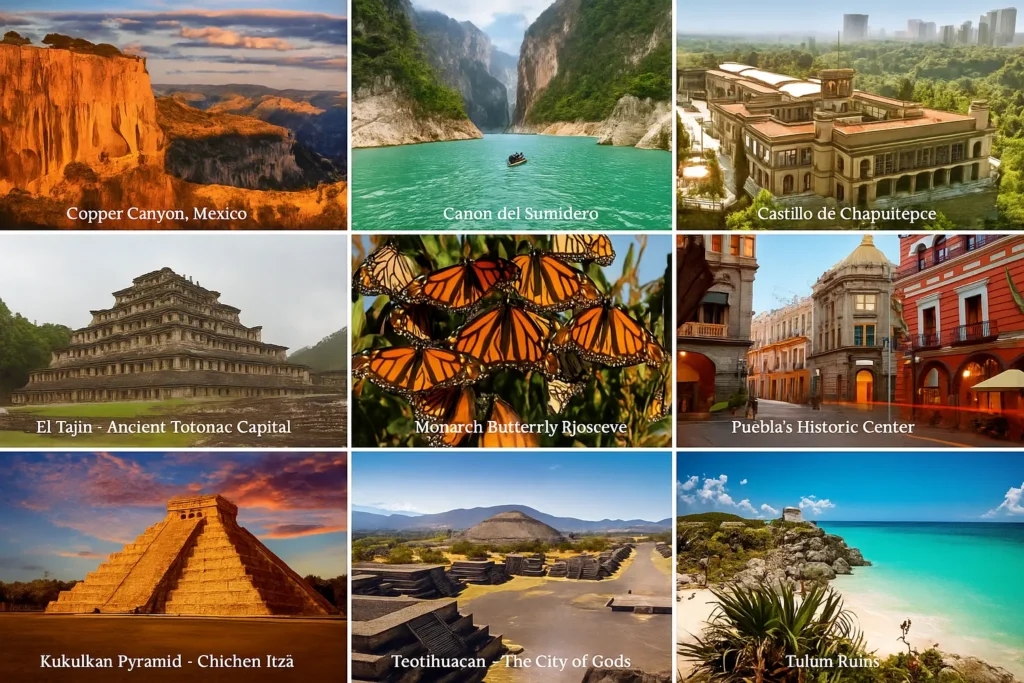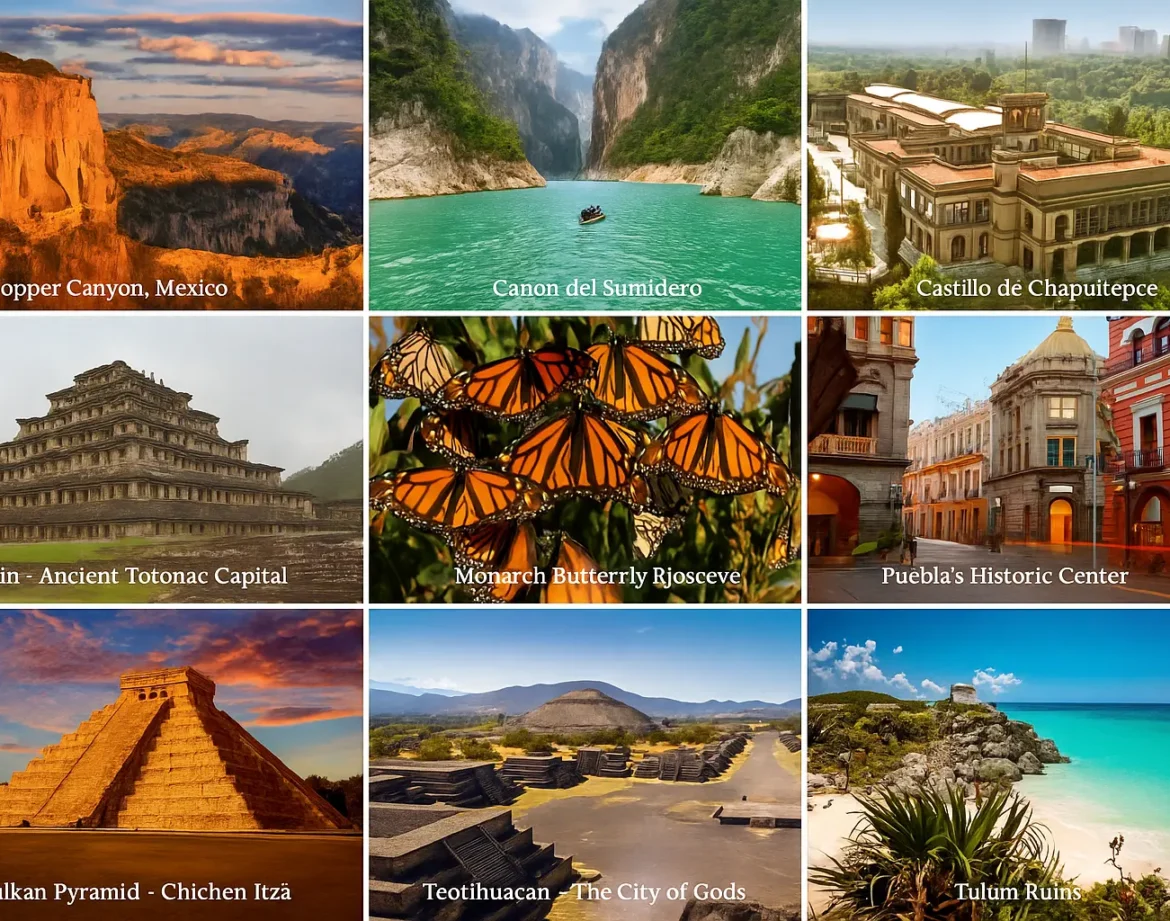7 Epic Man-Made Tourist Attractions in Mexico That Will Leave You Speechless

Introduction
Mexico isn’t just about beaches and tacos—it’s a vast country bursting with rich culture, ancient civilizations, and spectacular landmarks. From the Pacific to the Gulf of Mexico, travelers can uncover both nature’s wonders and awe-inspiring human-made marvels. If you’re searching for man-made tourist attractions in Mexico, you’ve come to the right place.
In this guide, we explore Mexico’s famous landmarks, delving into both ancient ruins and modern feats that showcase the country’s rich history, vibrant art, and innovative spirit.
Natural vs. Man-Made Attractions in Mexico
Before we dive into the must-see spots, let’s clarify the difference. Natural attractions are formed by the Earth’s processes, such as canyons and biospheres. In contrast, man-made landmarks in Mexico include architectural, historical, and cultural sites built by humans, such as pyramids, castles, and historic towns.
Cañón del Sumidero – Nature’s Monumental Canyon
Cruise the Grijalva River between towering cliffs and spot crocodiles in Chiapas
Book NowCañón del Sumidero – A Natural Marvel in Chiapas
Located in the southern state of Chiapas, Cañón del Sumidero is a dramatic natural canyon shaped by the Grijalva River. With walls reaching over 3,000 feet, this geological wonder also doubles as a national park rich in biodiversity.
Although it remained largely unexplored until the 1960s due to treacherous terrain and local legends, it’s now a thriving eco-tourist destination. Visitors can embark on boat rides that navigate through the canyon, passing crocodiles, birds, and ancient cave formations.
Copper Canyon – Mexico's Grandest Secret
Discover dramatic cliffs, Tarahumara traditions, and scenic train rides in Barrancas del Cobre
Book NowBarrancas del Cobre – The Majestic Copper Canyon
Known as Mexico’s answer to the Grand Canyon, Barrancas del Cobre (Copper Canyon) is a series of six canyons in northern Chihuahua. Larger and deeper than its U.S. counterpart, it’s a hidden gem that captivates adventurous travelers.
The indigenous Rarámuri people call this region home. For a unique experience, hop aboard the El Chepe train, which offers one of the most scenic rail journeys in the world—an unforgettable ride through dramatic cliffs, lush valleys, and charming villages.
Chichén Itzá – Kukulkan Pyramid
Stand before one of the New Seven Wonders of the World and witness Mayan brilliance
Book NowChichen Itza – The Pinnacle of Man-Made Landmarks in Mexico
No list of Mexico’s artificial tourist attractions is complete without Chichen Itza. Declared one of the Seven New Wonders of the World, this ancient Mayan city is nestled in the Yucatán Peninsula and draws millions of visitors annually.
Its centerpiece, the Kukulkan Pyramid, isn’t just a marvel of architecture—it’s an astronomical calendar. Every equinox, shadows create the illusion of a serpent slithering down its steps, symbolizing the return of the feathered god Kukulkan.
Beyond the pyramid, the complex includes ball courts, temples, and observatories—testaments to the Mayans’ architectural brilliance and cosmic understanding.
Monarch Butterfly Sanctuary
Witness millions of butterflies in flight through the misty pine forests of Michoacán
Book NowMonarch Butterfly Biosphere Reserve
While technically a natural site, the infrastructure supporting this sanctuary is human-designed for conservation. Located in Michoacán and the State of Mexico, the Monarch Butterfly Biosphere Reserve is a magical haven for millions of butterflies that migrate from Canada each year.
From November to March, visitors can walk through forests alive with fluttering monarchs—a sight so surreal it feels like a dream.
Chapultepec Castle – Mexico’s Imperial Gem
Visit the hilltop royal palace with panoramic views, lush gardens, and deep history
Book NowChapultepec Castle – Mexico City’s Royal Gem
Perched atop a hill in Chapultepec Forest, this opulent structure is one of Mexico’s most underrated artificial features. Once home to Emperor Maximilian I, Chapultepec Castle now serves as the National Museum of History.
With panoramic views of Mexico City, lush gardens, and neoclassical architecture, it’s no wonder this site has become a favorite for both tourists and locals. The surrounding park features a zoo, lakes, and museums, making it an ideal day trip destination.
Teotihuacán – The City of Gods
Climb the ancient pyramids of the Sun and Moon just outside Mexico City
Book NowTeotihuacan – The City of Gods
Located just 25 miles northeast of Mexico City, Teotihuacan is one of the most iconic artificial landmarks in Mexico. Once one of the largest cities in the ancient world, it was mysteriously abandoned long before the Aztecs stumbled upon it and named it “The Place Where the Gods Were Created.”
At its heart are the Pyramid of the Sun and the Pyramid of the Moon, enormous structures built without modern tools, cranes, or the wheel. Climbing to the top offers a breathtaking view of the Avenue of the Dead, flanked by ceremonial platforms and murals that still speak to the city’s spiritual and astronomical significance.
Today, Teotihuacan is a UNESCO World Heritage Site and a staple in any itinerary focused on famous landmarks in Mexico.
Puebla’s Historic Center
Stroll colonial streets lined with tiled mansions, cathedrals, and the birthplace of mole poblano
Book NowPuebla’s Historic Center – Colonial Brilliance Preserved
A lesser-known gem, Puebla’s Historic Center is a UNESCO-designated area featuring over 2,600 colonial-era buildings, characterized by their colorful tiles, intricate facades, and Baroque-style cathedrals. Walking through this area feels like stepping back in time.
Highlights include the Puebla Cathedral, one of Mexico’s most important churches, and the Biblioteca Palafoxiana, the first public library in the Americas. You’ll also find charming markets, local pottery, and the birthplace of the iconic Mexican dish mole poblano.
This city’s layout and architecture make it a standout among Mexico’s artificial tourist attractions with deep historical and cultural roots.
El Tajín – Ancient Totonac Capital
Discover Veracruz’s Pyramid of the Niches and immerse yourself in Totonac heritage
Book NowEl Tajín – Ancient Totonac Capital
Tucked away in the state of Veracruz, El Tajín is an archaeological site built by the Totonac people and flourished between 600 and 1200 AD. Its most famous structure is the Pyramid of the Niches, a perfectly symmetrical step pyramid with 365 niches—possibly representing the days of the year.
The site’s carvings and murals depict mythological scenes, ceremonial games, and everyday Totonac life, offering rare insights into a civilization not as well-known as the Maya or Aztecs. A trip here highlights the artificial features of Mexico that reflect indigenous innovation and cosmology.
Tulum Ruins – Cliffside Mayan Fortress
Discover ancient Mayan history with breathtaking views over turquoise Caribbean waters
Book NowTulum Ruins – Coastal Beauty with a Historic Twist
Few places blend natural splendor and artificial history as seamlessly as Tulum. Situated on a cliff overlooking the Caribbean Sea in Quintana Roo, the Tulum Ruins offer an unforgettable view of turquoise waters backed by a sprawling Mayan walled city.
Unlike other Mayan sites, Tulum was a thriving trade hub and one of the last cities to be built and occupied by the Maya. It’s compact yet powerful, housing structures like the Temple of the Frescoes and El Castillo, which were built for both astronomical and spiritual purposes.
With its beachside setting, Tulum proves that Mexico’s famous landmarks don’t have to be inland or massive to leave a lasting impression.

(FAQs)
What is the most visited man-made tourist attraction in Mexico?
Chichen Itza is the most visited site, attracting millions of visitors each year due to its global recognition and historical significance.
Are man-made landmarks in Mexico accessible year-round?
Yes, most are open year-round, though it’s best to visit during the dry season (November to April) for optimal weather.
Which man-made feature of Mexico combines history and nature?
Chapultepec Castle combines history, culture, and nature, sitting atop a hill in one of the largest urban parks in the world.
Can I explore these landmarks without a tour guide?
While self-guided visits are possible, hiring a local guide often enriches the experience with historical and cultural insights.
Are these sites family-friendly?
Absolutely! Sites like Teotihuacan, Tulum, and Chapultepec Park offer great educational experiences for families.
What should I wear when visiting historical landmarks in Mexico?
Comfortable shoes, sun protection, and lightweight clothing are ideal, especially for outdoor ruins like Teotihuacán and Chichén Itzá.
Why Mexico’s Man-Made Attractions Are World-Class
From ancient pyramids and colonial cities to royal castles and coastal ruins, Mexico’s artificial tourist attractions offer something for every type of traveler. They reflect the country’s diverse cultural heritage—from the Maya and Aztecs to Spanish colonists and modern innovators.
Whether you’re into archaeology, architecture, or adrenaline, Mexico’s famous landmarks will surprise and inspire you. So pack your bags, grab your camera, and prepare to explore the incredible artificial features of Mexico—you’ll leave with stories to tell for a lifetime.


